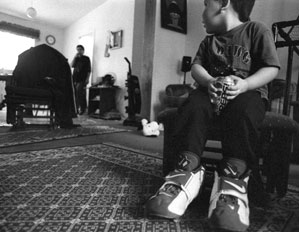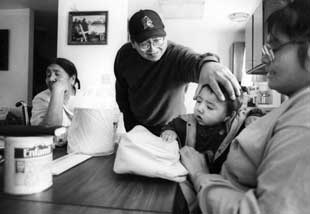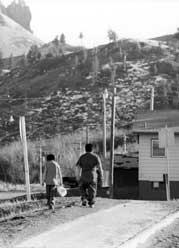|
|
||
|
At Rocky Boy’s,
a rough economic road Few businesses
exist to serve reservation residents. Story by Jared
Miller
A century ago, before there was a Rocky Boy’s Reservation, 450 destitute Chippewa and Cree wandered the Montana-Canada border in search of a home. Their livelihood, buffalo, had been exterminated, and so they searched, too, for a new way to sustain themselves. Four generations after the last buffalo hunt, the ancestors of those Chippewa and Cree have a reservation in northcentral Montana and their numbers have grown to 3,500, but their economic questions are still unanswered. Rocky Boy’s tribal leaders have tried to find ways to spur economic development, but most have proven fruitless. Unemployment often reaches 70 percent and what jobs do exist are primarily government-created. Subsistence is a way of life at Rocky Boy’s. Money that is generated on the reservation has negligible impact on the economy because so few businesses exist that dollars are spent off the reservation in stores in Havre or Great Falls. For Willie Stump, 41, and Ruby Sutherland, 35, descendants of those wandering tribal peoples, the struggle to survive Rocky Boy’s stark economy has been one of endurance against the social ills that shadow the reservation. The couple met young, teenagers in love, using drugs and alcohol to numb the realities of a life of poverty. Government assistance checks paid for their booze and for their rent. “We were a regular Bonnie and Clyde around the rez,” Stump says. “Runnin’ around. Gettin’ in fights,” Sutherland says. “We did everything.” “Christ, we were bad,” Stump says. Twelve years have passed since Stump and Sutherland last tasted a drink or tried a drug. Today they reflect on why they gave up that frivolous lifestyle and also the economic challenges they now must face. “When you get everything for free, you don’t appreciate it,” Sutherland says. “So we started working, you know, and earning our own money,” Stump explains. “When we started working, we started stretching it, realizing we can’t drink up our money all the time,” Sutherland says. Indeed, Stump and Sutherland are lucky. They have been able to find jobs on the reservation. And on a chilly Friday afternoon in March, they cruise to Havre to spend their wages. They head the 40 miles north in their blue, 1991 Dodge Caravan every Friday afternoon that Stump gets paid—$640 twice a month. They have four children, ages 3 to 15: Dallas, K.C., James and Deana. And they raise two more: Brian Jones and Daniel Sutherland, the children of relatives. The older children opted out of the trip to Havre this day. “In the summer time, you should see it,” Sutherland says. “I’ve got kids everywhere.” Stump makes $10.05 an hour driving a bus for Head Start. Ruby lost her job at Chippewa Cree Meats in January, a job she had for six years. She doesn’t collect unemployment benefits due to a disagreement over the reason she left the job. Stump and Sutherland make six stops in Havre. They make a payment on the van, fill up with gasoline, shop at Kmart, order two large pizzas to feed the children at home, eat a McDonald’s burger while the pizzas cook and they make a payment on their truck. The truck is in hock. “My brother got married and we hocked the truck to chip in on the wedding,” Sutherland explains. Six stops, and the $640 paycheck is gone. All of it. “That’s it on this check,” Sutherland says. “Next week, I’ll pay lights and buy groceries in Great Falls.” The two shop in Havre because they have to. Shopping on the reservation is sparse by any standard. The tribe-owned market carries only conveniences, and shoppers there pay dearly for them. A gallon of milk is $4. Diapers are three times the Kmart price.
At Kmart, Stump and Sutherland buy a tiny jumpsuit for their new nephew—born the night before—laundry soap, two 40-pound bags of generic dog food, Pringles and a skateboard for their 3-year-old, Dallas. The toy costs $20.99. Back in the van, Sutherland says, “There goes our grocery shopping. I knew we shouldn’t have gone to Kmart first.” “But we got commodities,” Stump answers, pumping his arm in celebration, grinning. He’s talking about the frozen chicken, frozen hamburger, lunchmeat and stew that Sutherland brought home Friday morning. Once a month most of Rocky Boy’s working families stock up on commodities, provided by the tribe, to feed them through the month. The unemployed get food stamps. Their paycheck gone, Stump and Sutherland head for home, a modular unit near the tribal offices. The house, like most of Rocky Boy’s houses, is fueled by propane. It burns about 100 gallons a month, at about a buck a gallon. The tribe-owned house was assigned to Stump and Sutherland. They can’t afford their own. “I think we got the house because Willie works,” Sutherland says. Seventy percent of Rocky Boy’s capable workers don’t have jobs. Ninety percent of those who do are employed by the tribe. They work for tribal health services, tribal housing, Stone Child College or the tribal market for an average salary of $25,000 a year, according to tribal attorney Daniel Belcourt. Just more than 20 Chippewa Cree have agriculture-related jobs, raising wheat or black Angus beef. But agriculture is strictly limited by the rugged landscape, a landscape that conspicuously changes from flat, farm-friendly plains into knotted, rocky foothills at the reservation border. “It’s historical that they put Indians on land that can’t be used,” says Richard Sangrey, the tribe’s chief of staff. “They stuck us up here in a pile of rocks,” says Tribal Councilman Pete LaMere. Rocky Boy’s Reservation stretches across 122,000 acres in the rugged foothills of the Bear Paw Mountains in northcentral Montana. The last reservation in the United States to be established, Rocky Boy’s is also the smallest of Montana’s seven Indian reserves. It was carved in 1916 from the defunct Fort Assiniboine Military Reserve by executive order.
The reservation’s limited land base forced tribal leaders in the middle of the last century to create a “freeze ordinance” restricting livestock producers to 150 head of cattle each. “You really can’t live off (livestock) unless you have about 300 head,” LaMere says. Robert Belcourt, natural resource specialist for the tribe, adds, “Agriculture producers here have other jobs to supplement their income.” Timber provides another meager revenue source for the tribe. Loggers have cut timber eight times since 1990 on 19,000 acres of commercial timberland. A few Indian families profited directly by participating in the harvests. Tribal profits were pooled into Bureau of Indian Affairs trust accounts in Albuquerque, N.M. Those accounts are now at the center of lawsuits in which a judge has found the BIA grossly negligent in its handling of the trusts and ordered a full accounting, which may prove almost impossible. Mining potential also exists at Rocky Boy’s. “We’ve got uranium, gold, silver and coal,” Sangrey says. But mining is outlawed for fear it would pollute groundwater. Most mineral deposits at Rocky Boy’s are located near reservation headwaters in the heart of the Bear Paw Mountains. A few tribal members, like Stump, work for public schools on the reservation. But those jobs are rare. One of the largest sources of income last year at Rocky Boy’s was firefighting. Four hundred fifty tribal members earned $1.9 million fighting forest fires, says Robert Belcourt, the resource specialist. “Most of that was either spent in Havre or Great Falls,” he says. “A lot of people bought cars,” adds Jim Morsette, chair of the tribe’s Economic Development Task Force. The economic link between Rocky Boy’s and Havre cannot be overstated. Rocky Boy’s tribal employees make roughly $7.1 million a year, most spent off the reservation. Havre Mayor Phyllis Leonard calls the reservation’s economic impact on her town “tremendous.” Havre’s Kmart store garners fully one quarter of its business from the reservations, either Rocky Boy’s or nearby Fort Belknap, says store Manager Steve Harr. “I know this store wouldn’t be the store it is without the reservation,” Harr says. The tribe also pays Northern Montana Hospital in Havre $2 million a year to contract medical services for tribal members ineligible for Medicaid, according to Tribal Councilman Kelly Eagleman. The cost of a 80-mile round trip commute to Havre makes it difficult for tribal members to recoup much of their investment by working minimum-wage jobs there. But that leaves Rocky Boy’s starved for cash and in unemployment straits. So why aren’t there more businesses on the reservation? The lack of access to startup capital is the biggest obstacle to small business at Rocky Boy’s, according to Jim Swan, vice president of RJS & Associates Inc., a consulting firm providing technical assistance and grant writing services for schools, tribes and colleges. RJS is Rocky Boy’s largest private business. “Banks can be racist and are more scrutinizing for loans for Indians than non-Indians,” Swan said. There’s another reason why banks won’t lend to Indians at Rocky Boy’s: all reservation land is held in trust by the tribe. Trust land cannot, in most cases, be used as loan collateral. RJS founder Bob Swan used capital he had already accumulated to start his business. Today, RJS thrives with 12 full-time Native American workers in its office and 60 consultants across the country, 90 percent of whom are Indian. “The reason this business was able to get off the ground is access to capital,” says Jim Swan. There are other business obstacles at Rocky Boy’s: • The reservation lacks infrastructure—water, sewer, roads—to support large businesses. • Rocky Boy’s, because of its remote location, is isolated from urban business opportunities, as well. Havre, a town of 12,000, is 40 miles north of the reservation center. The City of Great Fall lies about 100 miles to the south. • Tribal politics also impede economic development, Swan says. “(Tribal government) is like the federal government, but it’s small and cutthroat,” says Neil Rosette, an employee with RJS since its infancy. “It’s nepotism,” Swan says. “Tribal leaders and administrators hire people who are related to them or friends, simply on the basis of the personal relationship rather than on merit. “If you hire someone based on a social relationship, rather than on merit, you are putting a strike against your business because more often than not, they aren’t the best qualified,” • Jealousy among tribal members also prevents business success, they say. “If an Indian sees someone else succeeding out here,” Rosette says, “the jealousy steps in. We spend more time fighting against ourselves as Indians.” “Indian people are so suspicious of the American dream,” Swan explains. “As soon as someone starts succeeding, people might go around spreading rumors about them, for instance. It can be anything from little sniping to outright falsehoods being spread, back stabbing to out-and-out slander.” • Attitudes are also a problem, says Swan. “Historically, Indians have been beaten down so that the entrepreneurial spirit is not alive on the reservation,” he says. “If you think the mind-set of the people is going to change quickly, it’s not,” Rosette adds.
The result of so many economic obstacles is, of course, staggering unemployment and the resulting poverty. The effects touch everyone at Rocky Boy’s. They certainly touch Delia DeMontiney. DeMontiney is 77 years old, but you wouldn’t know it from her braided hair, dark as an evening shadow and long down her back. DeMontiney has been in a wheelchair for 10 years, since a stroke. Her cheeks are a spider web of wrinkles. DeMontiney is the granddaughter of the great Cree leader Little Bear, one of the reservation founders. “She’s a bigger part of the history here than you can imagine,” says Pete DeMontiney, one of her sons. Delia DeMontiney’s economic status is better than most of Rocky Boy’s 162 senior citizens. She draws both Social Security and veteran’s benefits, her late husband’s WWII legacy. And she pays only $33 a month to rent her home in a senior housing area. But DeMontiney’s relative prosperity is fettered by her children’s and grandchildren’s dependence.
DeMontiney’s daughter Mary and four of Mary’s five children, Cara, 9, Beau, 11, Nena, 14, and Sophia, 18, live in DeMontiney’s two-bedroom house. They have nowhere else to go. “They sleep all over,” says Haley DeMontiney, Delia DeMontiney’s second daughter. Haley DeMontiney is at the house this day washing laundry. She doesn’t work. She’s not married. She has children of her own. One of them, Delia DeMontiney’s grandson, was charged in March with deliberate homicide. Lionel James DeMontiney, a 17-year-old seventh-grade dropout, was among Rocky Boy’s unemployed when he allegedly killed his cousin Bryan Gopher, 24, during a shooting in Havre. He allegedly shot Gopher in the chest with a 9 mm handgun during an argument that escalated after police said DeMontiney chided his cousin for letting Gopher’s girlfriend boss Gopher around. His mother says her son tried unsuccessfully to get job training that would have taken him away from home and the incident never would have happened. The Kicking Horse Job Corps training center near Ronan had earlier rejected his application. “He wanted to go to Job Corps so bad,” his mother, Haley DeMontiney, says. Much of Rocky Boy’s crime, she contends, is the result of unemployment. “If kids want something, and they don’t have the money to get it, and their parent don’t have the money to get it, the kids find other ways, whether that’s break-ins or whatever,” she says. At the time of her son’s arrest, Haley DeMontiney worked part-time at the Tribal Health Board. “It was good to have a check for $80 every two weeks,” she says. “It helped for gas, but that’s it.” As Haley DeMontiney speaks, her mother is watching a country music video on TV. Faces of grandchildren gaze down from unframed photographs tacked to the wall. Below Delia DeMontiney’s wheelchair, a scrap of rug covers the carpet, sanded smooth by children’s feet. Broken kitchen tiles display the blackened pocks of discarded chewing gum. Kitchen cabinets lack doors. For those like Haley DeMontiney—single and unemployed—a tribal assistance program called General Assistance, or GA, helps pay the bills. DeMontiney is among 156 tribal members drawing GA payments. GA pays twice a month, on the 15th and 30th. The check average is $211. “It’s basically like welfare,” says Cecelia Parker, a GA caseworker. “Some start (receiving GA payments) when they turn 18,” adds Lisa Singer, another caseworker. “The only time they really get off is if they find a job,” Parker explains. “Or if they get married,” says Singer, “then they are referred to other federal programs.” Like her daughter Mary, Delia DeMontiney’s son Pete doesn’t have a home either, despite a new job at the Tribal Housing office. He lives at his in-laws’ home with his wife, Jodi, and their five children. “I tried to buy a home, and a lot of lending companies hedged on us because they didn’t want to have a loan on trust land,” he says during a tour of reservation housing. “They know if we default, they wouldn’t get the money back except through a lengthy legal process.” Pete DeMontiney is quiet and stoic. His broad face hides behind large prescription lenses. He is a basketball player. He has won many trophies.
DeMontiney drives through a tribal-housing conglomeration called Prairie View: rows of dilapidated houses linked by dirt lots. Litter abounds. Junked cars rest on cinder blocks or tree stumps. A satellite dish dangles from every house. Loose dogs—chows, rottweilers, pit bulls—rule this land. “As you can see, this is damn near Third World,” DeMontiney says. Pete DeMontiney and his family once lived in tribal housing. “It seemed like the minute we went somewhere, somebody was trying to break in,” he says. “The neighbors dealt drugs out of the house. It was common knowledge, but the criminal justice system can’t do anything. If they arrest one, there’s another ready to take their place. “Sometimes, it kind of looks like Beirut. Vandalism, burglary. Those are the reasons I wouldn’t live around these areas. Not to mention the dog problem. That’s another reason why businesses hesitate to come down here.” Later, after work, DeMontiney heads to his in-laws’ home for a ceremonial sweat with his relatives and a meal of pork and potatoes, corn with butter. Talk around the table is cheerful. There’s a new baby in the house. And there is talk of education, a common topic. DeMontiney’s mother-in-law, Sandy Murie, is the local superintendent of schools. Despite a 30-percent dropout rate, Murie says, economic woes at Rocky Boy’s today cannot be blamed on lagging education. “A lot of dropouts pick up their GED at Stone Child College,” Murie says. Many stay on to earn a two-year degree. “The education system is in place,” she says. “I don’t think that’s what’s holding us back. I think we need to go to the next step.” The next step in Rocky Boy’s economic development could be a big one. At any time, a state judge is expected to approve the tribe’s federal water agreement which will “forever settle the tribe’s water right’s,” according to Tribal Councilman Bruce Sunchild. The settlement entitles the tribe to an estimated $48 million, with $3 million earmarked for economic development. The remaining money will fund water resource development. A task force has been created to administer the $3 million, pending approval from the tribal council and the U.S. secretary of the Interior. No formal plans have been made for the money, but Jim Morsette, chairman of the task force, has some ideas. “We need a bank,” Morsette says. “If we had a bank, money could circulate a lot better.”
It might also improve access to business loans. The tribe also needs industry, Morsette says. “Manufacturing, that’s been my idea,” he says. “We’ll never be self-sustaining, I don’t think, but we’d like to have some company here to put people to work.” Morsette and his task force also recently won a $1 million grant from the U.S. Department of Housing and Urban Development. The grant will help create a non-profit Community Development Corporation. The CDC, as it is called, is designed to help the tribe find federal and private grant money for economic development projects. “It can be a magnet for funding,” says Paul Tuss, executive director of Bear Paw Development Corporation of Northern Montana, a group that helped Rocky Boy’s win the HUD grant. “The purpose is to add long-term stability to the tribal economy.” The people at Rocky Boy’s—people like Willie Stump, Ruby Sutherland, Delia DeMontiney, Haley DeMontiney and Pete DeMontiney—will be watching Morsette and the tribal council as they administer the funds. They’ll watch to see if these men can create an economy of jobs from a few million dollars. And they’ll continue as they have for countless generations, trying to make a living. |
Last
updated
9/18/04 2:57 PM
Table of Contents | About Us | Feedback | Links







